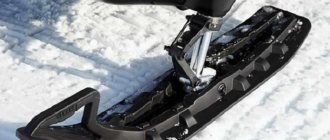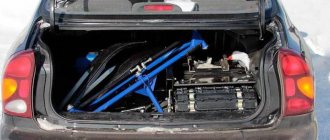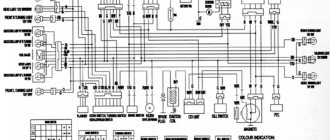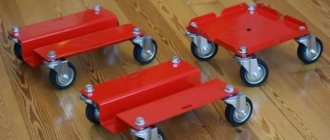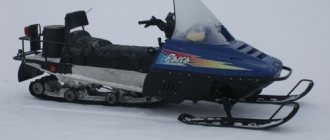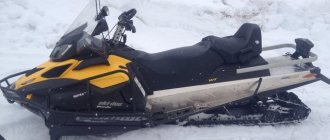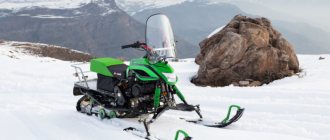IMPORTANT! Please read before using!
It is not allowed to start the engine of a vehicle with the hood, protective guards and covers open and unlocked. The maximum temperature for reliable engine starting using starting aids is -30 C°. Starting the engine at ambient temperatures below -30 C° is not guaranteed. Manual emergency engine start is provided.
A few words about the manufacturer
Irbis Motors was founded in 2001 by a group of young people passionate about motorcycles. They wanted to create equipment that would be accessible to the average buyer, but at the same time not inferior in quality to their Japanese and European counterparts. The first scooter to appear was the Z50R, which was a resounding success. Users liked the model so much that it was later re-released several times, adding improvements.
Currently, the company has a well-developed network of official dealer centers, and the main office is located in Moscow. The manufacturer has more than 30 models of motorcycles of various types, including road bikes, pit bikes, sports and other models. In addition to motorcycles, scooters, ATVs, snowmobiles and motorized towing vehicles are produced under the Irbis brand.
Generation "Dingo"
The first dismountable snowmobile, the Irbis Dingo T110, was released in 2012; according to its markings, it had a 110 cc air-cooled engine. Moreover, the weight of this all-terrain vehicle was 108 kg. At one time, this snowmobile caused a sensation, because it could be disassembled in five minutes.
Two years later, the T125 model was released, which had a larger oil-cooled engine and weighed 2 kg more.
In 2022, the third generation Dingo T150 appeared. A more powerful 4-stroke power unit was installed on board, which had a mixed cooling system - air and additional oil. The all-terrain vehicle also received a longer track, thanks to which it behaved better on loose snow. Despite its compact size, this “snowball” could withstand a load of 150 kg. The main difference between the latest model was the presence of an automatic transmission, while the previous ones had a manual transmission.
This model has received very flattering reviews from its owners. Subsequently, it underwent several modifications. At the beginning of 2022, a new fifth generation appeared.
User manual
Snowmobiles "Irbis Dingo 150" have a classic design: two skis in front and one track in the back - three points of support. It is designed for driving at temperatures from -40 to +5 degrees. This mini snowbike is still disassembled into several parts. Detailed step-by-step instructions with images for each item can be found in the proposed “Operation Manual”. In addition to the all-terrain vehicle itself, the kit includes a set of tools for assembly and disassembly.
The new snowmobile comes with special transport oil in the engine and gearbox. Before starting operation, it should be replaced with motor oil that is suitable for the design.
Break-in recommendations
Like any other snowmobile, the Dingo 150 needs to be broken in. This period is an important stage, since its further technical condition and service life depend on how the bike is used at first.
Running in the power unit takes at least 20 engine hours, which approximately corresponds to 500 km. After this, he will be able to work at full capacity.
Recommendations from the manufacturer:
- continuous engine operation time – up to 60 minutes;
- maximum speed – 30 km/h;
- avoid heavy loads (long climb uphill, increase speed to 7 thousand per minute);
- drive with frequent changes in speed;
- change the oil after the first 100 km.
Daniila Rukin
Snowmobile specialist "Buran". I go fishing in my free time.
Ask a Question
The new belt on the variator breaks in during the first 50 km. During this period, sharp braking and prolonged acceleration should be avoided. It is also better not to tow a load or drive for a long time at the same speed.
If any malfunctions occur during the break-in period of the new snowbike, you should contact only an authorized service center. Under no circumstances should you try to fix the car yourself. This may result in loss of guaranteed service.
Timing and frequency of maintenance
As with any snowmobile, it is necessary to carry out full maintenance when putting the all-terrain vehicle into operation after a long period of inactivity. Below are recommendations from the manufacturer that will be relevant for new cars purchased from an official dealer.
Recommendations for timing:
| Serial number of maintenance | Time since sale (months) | Mileage (km) |
| 1 | 1 | 100 |
| 2 | 3 | 500 |
| 3 | 6 | 1000 |
Maintenance dates are given in two versions, because they depend on which comes first. Further maintenance should be carried out either every six months or after the next 500 km.
The guaranteed service period is 3 years from the date of sale or up to the first 3 thousand kilometers.
Ways to make it easier to start the engine in severe frost:
- When you have finished driving, before turning off the engine, press the throttle lever firmly several times. The spark plug will be cleaned and the snowmobile will be easier to start next time.
- Start the snowmobile periodically to warm up the engine. At a temperature of about -30 degrees, the engine cools down to air temperature in 30-40 minutes.
- Remove the battery from the snowmobile and keep it warm when parked for long periods of time.
- Do not allow the battery to over-discharge; if possible, do not leave the snowmobile in severe frost for a long time (starting at low temperatures harms the engine).
Driving a snowmobile is a fun experience and we hope that you will truly enjoy it.
Do not allow children to drive this vehicle
. This could result in serious injury. Remember that to operate a snowmobile legally, you must have a tractor driver’s license of the appropriate category, and also register your snowmobile with the State Technical Supervision Authority.
Remember, your snowmobile is not intended for public roads .
.
Specifications
The Dingo 150 snowmobile has good technical characteristics and a good price-quality balance. The 2022 snowmobile received a reinforced tow bar and a battery in the seat case. This allows you to reduce the time required to replace and maintain a vital component.
In addition, the updated collapsible snowmobile all-terrain vehicle has enlarged footrests, a quick-release windshield and steering wheel. In both cases, tongue-and-groove connections are implemented to simplify the disassembly and assembly process. Instead of the blower shaft, which was used on previous models, a damper coupling is used.
Engine, how many cubes
This all-terrain vehicle is equipped with a four-stroke power unit with one cylinder and a forced air-oil cooling system.
Main technical indicators of the motor:
| Volume (cc. cm) | nominal | 150 |
| worker | 149,6 | |
| Power | 9.25 l. With. | |
| Torque | 6,000 rpm | |
| Launch | Electric and manual starter | |
| Nutrition | Carburetor with additional heating of the throttle diffuser |
The updated snowmobile is capable of reaching speeds of up to 45 km/h.
The model has additional engine crankcase protection, which is one of the main innovations of the fifth generation Dingo T150 snowmobiles.
How many liters is the tank
The new irbis has a separate lubrication system. The fuel tank holds 7 liters. It is recommended to use AI-92 gasoline.
Dimensions and weight, length
The dry weight of the snowmobile is 153 kg. Moreover, its maximum load capacity is 150 kg.
Key indicators (in meters):
| Length | 2,57 | |
| Width (including skis) | 0,965 | |
| Height | on the saddle | 1,065 |
| on the windshield | 0,715 |
Brakes
The new snowbike has a mechanical disc brake with a hydraulic drive.
Suspension
This snowmobile bike has a frame in the form of a durable steel frame. The diameter of the tube is 2.22 cm. This type of frame is fundamentally new and has attachment points to both the track mechanism and the engine.
Daniila Rukin
Snowmobile specialist "Buran". I go fishing in my free time.
Ask a Question
The frame thickness is 0.15 cm. It is made of a solid steel sheet and has additional reinforcement.
As would be expected in accordance with the design of a collapsible mini snowmobile, an independent multi-link type suspension is installed at the front. This type of suspension appeared only in fifth-generation models, but has already proven itself well on other snowmobiles produced by Irbis Motor - SF and Tungus. The skis are represented by a typical rotary support mechanism.
At the rear there is a sliding-roller suspension with shock absorbers. They can be adjusted according to their design.
Transmission
When it comes to the transmission, there are no surprises here. Like the vast majority of other modern snowmobiles, the Irbis Dingo has a CVT with three gears:
- F – front;
- N – neutral;
- R – reverse (reverse).
In addition, the model uses a dry centrifugal clutch.
Mover
The propeller is a Composit track mechanism, in which the drive sprockets are located in the front of the machine. The drive is a chain with 22 links and a pitch length of 1.6 cm.
The updated all-terrain vehicle has skis 1.02 meters long. The width of each ski track is 14.5 cm.
Main parameters of the caterpillar belt:
| Type | reinforced, rubberized |
| Length | 2.626 m |
| Width | 38 cm |
| Lugs | 2.3 cm |
| Number of windows | 52 pcs |
| Distance between windows | 5.05 cm |
In addition, the caterpillar mechanism is equipped with rubberized rollers and a screw tension mechanism. The tensioner is a so-called graphite-filled shoe.
Electrical equipment
The snowmobile has a halogen front headlight. Optionally, heated gas trigger and steering wheel are installed.
CONTENT
- Safety precautions
- Description of the snowmobile DINGO T150
- Disassembly/assembly order
- Identification numbers
- Specifications
- Snowmobile device
- Main controls
SAFETY
A snowmobile is a high-risk vehicle. Driving a snowmobile is different from driving other vehicles, including ATVs and cars. Even during normal maneuvers such as turning, driving up hills, or driving on uneven surfaces, a collision or vehicle rollover can easily occur if all safety precautions are not taken.
- Please read this manual and all symbols carefully and follow the operating instructions provided.
- Do not operate a snowmobile without proper training. Do not allow people who do not have a tractor driver’s license of the appropriate category and the necessary driving experience to operate a snowmobile.
- It is prohibited to drive a snowmobile while under the influence of alcohol or drugs.
- Always use extreme caution when driving in unfamiliar terrain. Be prepared for changing terrain conditions when operating a snowmobile.
- Always keep both hands on the steering wheel and both feet on the running boards while driving.
- Do not operate the snowmobile on slopes that are too steep for the vehicle and your experience. Practice on small slopes before attempting larger ones.
- Jumping and other stunts are not allowed.
- Never select too high a speed unless it is suitable for your skills and operating conditions. Always adjust your speed according to the road, visibility, operating conditions and your experience.
- Always follow the inspection and maintenance procedures outlined in this manual. Before each use of your snowmobile, make sure it is in good condition and safe to operate.
- Do not operate a snowmobile without an appropriately sized safety helmet. It is also necessary to wear eye protection and clothing appropriate to weather conditions.
- When driving long distances, always carry a reserve supply of fuel with you.
- Always follow the appropriate instructions in this manual when crossing an inclined surface. Avoid slides with excessively slippery or damaged surfaces. Shift your weight towards the lift. Never turn your snowmobile on a hill until you have mastered the technique for turning on level ground. If possible, avoid crossing steep hills.
- Always follow the appropriate instructions in this manual when descending and braking on a hill. Inspect the road carefully before descending. Shift your weight back.
- Never go down a hill at high speed. Avoid going downhill at an angle that could cause the snowmobile to lean to the side. If possible, go straight down.
- Never exceed the load capacity of your snowmobile. The transported cargo must be evenly distributed and securely secured. Leave plenty of braking distance.
- Never repair your snowmobile using inappropriate equipment or tools.
- Always follow the appropriate instructions in this manual when entering the slide. Check the road surface first. Never drive up a hill on too slippery roads.
- or a road with damaged surface. Shift your weight forward. Never drive up a hill at high speed.
- Always follow the appropriate recommendations if, when entering a hill, the engine stalls or the vehicle goes backwards. To prevent the engine from stalling when driving up a hill, maintain a uniform speed.
- Be careful when sliding or skidding. Learn to steer safely when sliding or skidding by practicing at a reduced speed on a flat, smooth surface. On extremely slippery surfaces such as ice, drive slowly and be very careful to reduce the risk of slipping or skidding.
- It is prohibited for anyone under the age of 18 to operate a snowmobile.
DESCRIPTION OF THE SNOWMOBILE DINGO T150
Purpose of a snowmobile.
The DINGO T150 snowmobile is an off-road mechanical vehicle designed for the movement of people and the transportation of goods on snowy terrain at ambient temperatures from plus 50 C° to minus 400 C°. Due to the design features of the snowmobile, prolonged driving on ice or compacted snow is not allowed, as this can cause the slip linings of the track unit to burn. If such a trip is necessary, periodically travel to areas with loose snow to lubricate the slip linings.
Snowmobile design.
The DINGO T150 snowmobile is created according to the classic “two skis in front/one track in the back” design.
When using this scheme, the snowmobile rests on the surface with three points arranged in a triangle. Thanks to this, the snowmobile has optimal stability, sufficient to solve most problems facing it. Also, this design is the key to its relatively low weight, optimal location of the center of gravity, disassembly and repair accessibility of all main components and assemblies. The DINGO T150 snowmobile is equipped with a four-stroke gasoline carburetor engine with a volume of 149.6 cubic centimeters with forced air and additional oil cooling (oil radiator). The carburetor is equipped with automatic heating of the throttle diffuser, which guarantees its stable operation in a different temperature range.
The DINGO T150 snowmobile is equipped with an automatic CVT transmission. The transmission mode shift lever is used to switch to reverse or forward gear, as well as engage neutral gear. The snowmobile is equipped with a track 2626 mm long and 380 mm wide, with lugs 23 mm high, and a roller-slide suspension of the crawler bogie with two shock absorbers, with the possibility of adjustments. The snowmobile is equipped with two-position heated handlebars and throttle trigger, a socket for external 12V devices, a closed seat space with pockets and load holders, a windshield, an electronic multi-mode instrument panel, an emergency engine shutdown system, a backup engine start system, and a hydraulic disc brake.
DISASSEMBLY / ASSEMBLY PROCEDURE
1. Unscrew the two screws securing the steering wheel.
2. Remove the windshield.
3. We fix the steering wheel on the plastic of the tank as shown in the figure.
3. Unscrew the central screw securing the plastic of the motor block.
4. On the left and right sides of the snowmobile, unscrew the screws securing the seat frame.
5. Remove the plastic of the motor block as shown in the figure.
6. Disconnect the headlight connector.
7. We completely remove the plastic of the motor block.
8. Open the seat lock.
9. Recline the seat.
10. Unscrew the two screws securing the seat frame to the track block frame.
11. Disconnect the connectors for the rear light and temperature sensor.
12. Remove the seat with the frame.
13. Unscrew the screw securing the footrest located in the front of the snowmobile (on the left and right sides of the snowmobile).
14. Remove the footrest (on the left and right sides of the snowmobile).
15. Pay attention to the method of fixing the side step in the rear of the snowmobile (the step must be inserted into the groove on the frame), and also...
16. ... in the front of the snowmobile.
17. Remove the chain casing. Pay attention to the casing latch (highlighted in green in the photo).
18. Using a 19mm socket wrench, loosen the chain tensioner nut.
19. To further remove the chain, it is necessary to move the chain tensioner to the position shown in the figure.
20. Remove the chain.
21. Unscrew the two screws securing the motor block frame to the track block.
22. We divide the snowmobile into two parts - the track block and the engine block.
23. After completing step 22, the snowmobile will look as shown in the figure.
24. In order to disconnect the front suspension block, you need to unscrew the central screw...
25. ... and two side screws.
26. Disconnect the engine block and the front suspension block.
27. Unscrew the skis.
28. Remove the skis from the front suspension block.
29. After this procedure, the ski block will look as shown in the figure.
30. Unscrew the towing eye.
31. Remove the trunk. Pay attention to the method of fixing the trunk to the snowmobile frame (highlighted in green).
Disassembly Features
To disassemble this snowmobile, you need to perform the following steps:
- Unscrew the fastening screw of the windshield and steering wheel bracket. Take them off.
- Unscrew the central fastening screw of the plastic protection on the motor block.
- Remove the fasteners from both sides of the saddle frame.
- Remove the plastic from the motor block.
- Fold the seat back and remove the fastening screw.
- Remove the battery and seat. Be sure to first disconnect all wires from the battery.
- Unfasten and remove the footrest.
- Remove the chain guard and carefully remove the chain.
- Disassemble the snowmobile into two parts - the track block and the motor block, after first disconnecting the rear light block.
- Unscrew and remove the track from the steering knuckle.
- Remove the trunk by unscrewing the towing eye.
To assemble the all-terrain vehicle, you should perform the same steps, only in reverse order.
Test Drive
Some compare this budget snowmobile with expensive models that cost an order of magnitude higher. However, this is not a completely appropriate comparison. A test drive shows that the car performs quite well on packed snow. Thanks to the long caterpillar, it practically does not bury itself in areas with loose snow.
At the same time, the all-terrain vehicle confidently reaches a speed of up to a maximum of 45 km per hour. If you believe the reviews of the owners, it consumes relatively little fuel - about 8 liters per 100 kilometers. Despite the fact that the tank capacity is 7 liters, the trunk allows you to take an additional canister with you.
In addition, this “snowball” is very knowledgeable. In parts it fits well in a car like the UAZ “Patriot”. At the same time, test runs show excellent cross-country ability - it passes in those places where an all-wheel drive vehicle sits on the bottom.
Reviews
- Vitaly, Primorsky region. The Dingo 125 snowmobile is a difficult machine to get used to if you have straight hands. I had my father’s Buran snowmobile, I studied it inside and out. Dingo also has good maintainability. Of course, problems regularly arise related to starter malfunctions and engine overheating. There are frequent malfunctions in fuel lines and electrical wiring. There are also common problems with the battery, which sometimes discharges out of the blue. And then it works again as if nothing had happened - this is probably due to the frost. When braking, a crunching sound is clearly audible - this is probably due to freezing of the chassis elements. The track and skis are made of cheap materials, as is everything else. The car is not particularly durable, but the spacious trunk allows you to carry with you various parts that will be needed in case of repairs in the wilderness. Well, at least then you won't have to call a tow truck. The snowmobile is easy to control, has a soft suspension, and a maximum speed of 40 km/h. Fuel consumption is no more than 10-12 liters of 92 gasoline per 100 km.
- Nikolay, Yaroslavl. I bought a Dingo 125 from a friend of mine who kept the car well. The device is in good condition, without damage to the body. I had to do some electrical digging to get the dashboard to show correctly. The battery was dead - I had to replace it, and the snowmobile drove like a charmer. In terms of cross-country ability, the Dingo 125 is not the best option, and you often have to push the car to get out of another snowdrift. A weak motor makes itself felt. As a result, I came to the conclusion that this snowmobile is not suitable for difficult off-road conditions. I try to move slowly on smooth roads - the quieter you drive, the further you will go. But sometimes you still have to climb into a snowdrift, and then problems begin - for example, due to the low position of the engine, snow gets inside and extinguishes the spark plugs. For such cases, I always have the tools and necessary parts with me.

